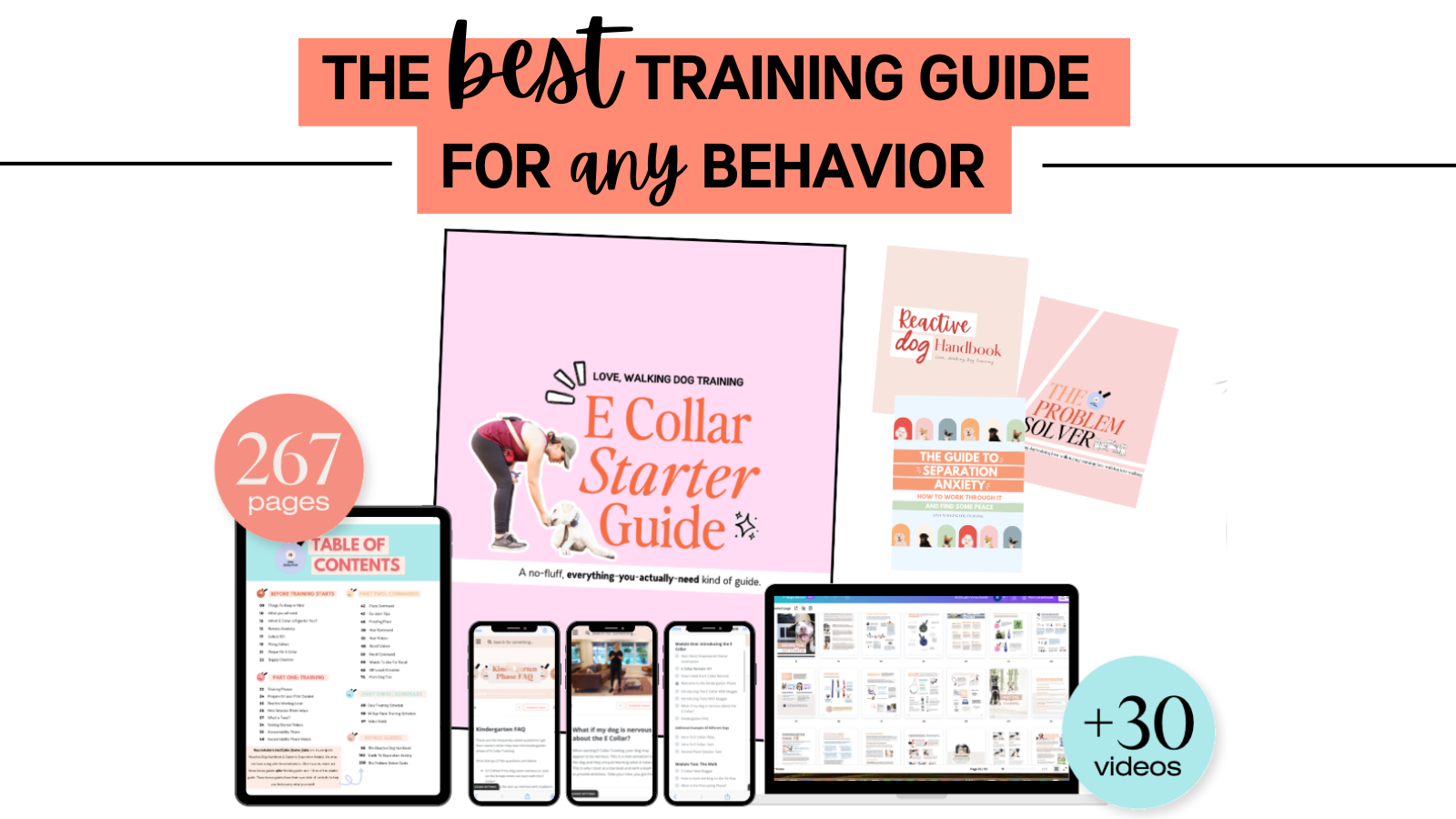How can the E Collar help you with your dog’s Separation Anxiety?
If you’ve never seen what this tool can actually do for your and your dog, I get why it doesn’t make sense. There is so much information out there from people who have never used the E Collar, but love to tell everyone why it’s so bad. It’s scary for owners. You’ve probably heard things like, don’t use the E Collar, because it will ruin your dog - or your dog will be scared of you.
When the truth is - I’ve never seen that happen. Any of it. And this is coming from someone who actually uses the E Collar - it’s what I do. But it’s much easier to remember the scary stuff.
So let’s break it down.
Think of the E Collar as an interruptor. With 100 levels, you can find a level that means enough to snap your dog out of the anxious loop (the barking, howling, scratching at the kennel door, whining). You can also try to do this by banging your hand on the kennel, but that is usually a frustrated response. We can’t take it anymore - STOP IT.
But when you use the E Collar, it takes the emotion out of it. We can be clear. Keep our cool. No yelling. No frustration.
Just some freaking clarity.
The most common question I get about using the E Collar and anxiety - won’t it make my dog’s anxiety worse?
My answer - it’s all about how you use it.
// be sure to check out our E Collar Starter Guide to learn how //
Check out the video linked below to see how I start by using the E Collar on walks.
The E Collar provides clarity. Using the E Collar to interrupt the anxious loop (whining, barking, pawing at the kennel, biting the crate door, pacing) helps us be crystal clear with our dogs. Without clarity, they will remain in the anxious loop.
What if a moment of slight discomfort from the E Collar could help your dog stop the behaviors that lead to all the anxiety? Make it possible for them to relax and not worry so much?
// That’s only if you need higher levels to interrupt the anxious loop - which is helpful for some. But for other dogs, sometimes lower levels (there’s 100 to work with) are enough. //
And maybe you’re thinking of your dog’s anxiety in human terms. I’ve heard some behaviorists refer to separation anxiety as a panic attack. Hearing this can make working through the anxiety that much more challenging for an owner.
But in my experience, it’s not always that complicated.
And I know this because I’ve seen a dog go from barking and biting at the kennel door, to stopping and laying down (and finally being able to fall asleep in the kennel) in a matter of seconds. With the help of an interruptor - the E Collar.
Dogs do what they are allowed to do. Sometimes it’s that simple.
Once you are able to address the Separation Anxiety (interrupting the anxious loop) it creates space for your dog to do something else - LIKE CHILL. But if they are allowed to continue the barking-whining-howling, they will continue to be anxious.
Using the E Collar to address separation anxiety will look different for all dogs. Please keep this in mind. If you were looking to sign up for a board and train program with a trainer who works with SA cases, it will probably be a minimum of 3-4 weeks. It’s a process that can take time for dogs with serious separation anxiety.
There is a spectrum when it comes to SA - from mild to intense. Depending on your dog, the training process will differ.
For me, separation anxiety and leash reactivity (when a dog barks, lunges, and whines) are very similar. If I’m working with a dog whose reactivity is a bit more mild, it might not take much to work through it. Similar to anxiety.
But when I’m working with a dog, who is not only reacting on leash, but their intent is to do harm - it’s like going to rehab. The process is longer. More exposure is needed. All the things.
If you have a dog with mild Separation Anxiety, it might take a few sessions with the E Collar to end the anxious loop.
But for a dog who is trying to break out of their kennel, and harming themselves in the process, there’s a lot more “exposure” that’s needed.
If we put it into human terms - one dog might need to go to “rehab” for a few months compared to another, who might do just fine with a few “therapy” sessions.
I wish I could talk with dogs about this stuff. Get in their heads. Dig deep to uncover it all. But I can’t. Because they are dogs.
So what do I mean by exposure? When working through a problem behavior with your dog (Separation Anxiety is a problem), it’s helpful to expose your dog to the very thing they struggle with most.
If your dog is anxious in their kennel, I would recommend setting up a situation to work through it. You would get a baby monitor, or some kind of camera so you can see your dog when you leave. An exposure session for you would look like putting your dog in the kennel, pretending to leave, standing outside the door and watching the camera. You would have your E Collar ready to address any barking, whining or pacing.
An exposure session for a reactive dog (reactivity is a problem) might look like working outside of a dog park. If they struggle with reactivity towards dogs, getting them around dogs to address the reactivity is an essential part of the rehabilitation process.
As I’m currently writing our next ebook - The Guide To Separation Anxiety (can’t wait to share it with you!), the feedback I’ve been getting from you over on Instagram is that you don’t understand how the E Collar can be used to help with Separation Anxiety.
And I know many of you are struggling with it. There is so much more to this stuff, but if you think E Collar training sounds like your next right move, check out our E Collar Starter Guide. It’s packed with everything you need to get started with this new tool and feel confident knowing you’re doing it the right way.
Using it for Separation Anxiety is a game changer, but I would recommend introducing the “language” of the E Collar first.
And now we have The Guide to Separation Anxiety included in the ECollar Starter Guide to show you how to use the E Collar to interrupt the anxious loop and help your dog tap into their calm mindset.
Love, Bethany
And ps: by sharing information with you, I'm not claiming to be an expert. I just want to share what has worked for me with dogs that have separation anxiety, and I’m hopeful it will help you in some way.


